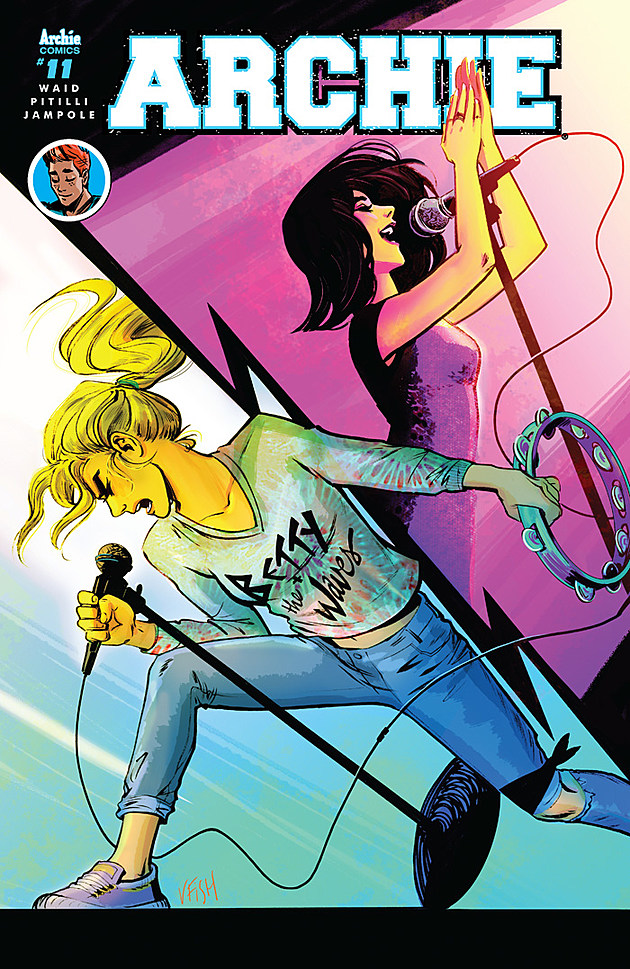There are many comics coming out every month, so it’s easy to lose track of promising new releases. That’s why we here at
Critical Writ have started "Make a Solicit Check"—a monthly column devoted to the most inspiring announcements.
This month: Wakandan lesbians, princess detectives, and genderqueer knights!
10. Don’t Panic
Mother Panic #1 – Jody Houser, Tommy Lee Edwards (DC/Young Animal)
The final title of the first wave of Gerard Way’s DC imprint Young Animals—this time written by
Faith’s Jody Houser. The titular Mother Panic is a vigilante identity used by Violet Paige—Gotham’s newest "celebutante"—to get revenge for her traumatic childhood. It sounds like a curious antithesis to Faith, whose escapades Houser scripts over at Valiant. Also it seems like
Mother Panic is the most connected to DC universe of all the Young Animal titles, what with the outright mention of Gotham City.
Mother Panic #1 is set to be released on November 9.
09. No More Days
Spider-Man: Renew Your Vows #1 – Gerry Conway, Ryan Stegman
Well, it might be in a separate universe, but Mary Jane and Peter Parker are back to being married and having their daughter, Annie. With a twist—both MJ and Annie have Peter’s spider powers, turning superheroing into a family business.
Spider-Man: Renew Your Vows #1 is set to be released on November 9.
08. From Hitwoman to P.I.
Angel City #2 – Janet Harvey, Megan Levens (Oni Press)
In last month’s struggle to cover most of Marvel’s new announcements, I ended up ignoring the release of Oni Press’s new female-led comic: a 1930s noir story. Time to fix this oversight.
Angel City stars Dolores Dare, former Hollywood hopeful, current enforcer for the Volante mob family. This changes when her best friend is found, another victim of the April Fool’s Killer. She starts her own investigation, which ends up setting her against a conspiracy of Hollywood studios, LA’s finest, and her own gang peers.
The first issue is set to be released on October 5; the second issue is coming out on November 16.
07. Have You Seen This (Bat)Man?
Super Powers #1 – Art Baltazar, Franco (DC)
Fans of adorable comics
Tiny Titans and
Superman Family Adventures—rejoice! The creative duo behind those titles is back with a new miniseries filled with cuteness and fun. Batman has gone missing and Wonder Woman is on the case. After Superman finds a clue in Gotham, she begins her search—in
space!
Super Powers #1 is set to be released on November 23.
06. Emptying the 8house
Arclight #3 – Brandon Graham, Marian Churchland (Image)
Last year, Brandon Graham started his new project for Image:
8house. It was a line of miniseries published with the same main title, but otherwise completely unconnected. Those series were Graham and Marian Churchland's
Arclight, Graham and Xerxe D. Penalta’s
Kiem, Helen Maier and Fil Barlow’s
Yorris and, finally, Emma Rios and Hwei Lim’s
Mirror. The twist was that all four minis would be published incomplete (only 1 or 2 issues) and moving to the next in the order I listed them—until
Mirror, which would be the first released in its entirety. And then everything else would be finished in the opposite order:
Yorris,
Kiem and, finally,
Arclight. Basically, it was an attempt to imitate the structure of
Cloud Atlas (the book, not the movie) with monthly published comics.
It didn’t work out, thanks to delays and not exactly sky-high sales, and the project was mostly dropped. By which I mean: all the series will end (
Mirror ended earlier this year), but not as part of
8house, and not in the order presented above.
And thus we get to
Arclight, which tells the story of the titular genderqueer knight, helping free his sorcerer princess trapped in an alien body, in a beautifully-rendered science-fantasy world. The first two issues are available digitally, so there’s plenty time to catch up with the series before it returns.
Arclight #3 is set to be released on November 23.
05. Fresh Meat!
New Talent Showcase #1 (DC)
A while back, DC started its Talent Development workshop for writers and artists, where entrants would learn from the company’s master storytellers. (Insert joke about DC’s less-than-stellar track-record of stories from their masters here.) The catch is that a resumé had to be submitted to be part of the workshops—this means this one-shot, which features stories written by its graduates, boasts about showcasing "new" talents even though most of them have already been working in the industry for a while. Chris Sebela, Michael Morecci, Joëlle Jones and
Long Walk to Valhalla co-writer Adam Smith are the biggest stand-outs. On the plus side, the list of writers is diverse and it’s nice of DC to give a chance for writers to play in their toybox, even if it's just for one issue.
The full list of featured authors is as follows: Vita Ayala, Emma Beeby, Joelle Jones, Hena Khan, Michael McMillan, Michael Morecci, Erica Schultz, Christopher Sebela, and Adam Smith.
New Talent Showcase #1 is set to be released on November 30.
04. #TakeBackJustice
Occupy Avengers #1 – David F. Walker, Carlos Pacheco (Marvel)
If there’s one lesson from
Civil War II, it’s that you can’t trust superheroes to do their job instead of petty squabbling. That’s where Hawkeye (Clint Barton) and friends come in, standing up for the little people. After
Nighthawk and
Power Man and Iron Fist, David F. Walker is among the best Marvel writers, so this is a comic to look out for. And if you’re worried there’s no sign of the other Hawkeye, Kate Bishop, don’t worry and have patience—she’ll star in her own future comic titled
Hawkeye by Kelly Thompson, and with art by Leonardo Romero. We’ll keep you updated.
Occupy Avengers #1 is set to be released on November 2.
03. The Study in Cute
Mega Princess #1 (of 5) – Kelly Thompson, Brianne Drouhard (Boom! Studios/KaBoom)
Speaking of Kelly Thompson: the writer of
Jem and the Holograms and
A-Force is teaming up with a Disney artist, Brianne Drouhard, to tell a new all-ages comic for KaBoom, a Boom! Studios imprint.
Princess Maxine gets the traditional gifts from her fairy godmother on her tenth birthday, none of which she actually cares for because they don’t help her achieve her greatest dream:
to become a detective. And when her baby brother, Prince Robert IV, goes missing, she and her sarcastic pony Justine are on the case! And those Mega Princess powers might actually come in handy.
02. Beyond the Panther
Black Panther: World of Wakanda #1 – Roxanne Gay, Alitha Martinez (Marvel)
Ta-Nehisi Coates’s current
Black Panther run is a smash hit for Marvel, and a damn good comic for an industry newcomer. And now it’s getting a companion book that will fill in the blanks in world-building and develop the comic’s supporting characters. The first arc will be written by renowned writer Roxanne Gay, with art by Alitha Martinez; it will focus on Ayo and Aneka, the former Dora Milaje lesbian lovers, and will depict the blossoming of relationship before the start of Coates’s run. The first issue will also have a back-up story by Coates himself and poet Yona Harvey, with art by Afua Richardson; this one will focus on another female character, the Panther’s mysterious antagonist Zenzi.
Black Panther: World of Wakanda #1 is set to be released on November 9.
01. Be the Change
CBLDF Liberty Annual 2016 (Image)
Comic Book Legal Defense Fund is a wonderful organization, founded in 1986 to protect the First Amendment rights of comic book creators, publishers and retailers by covering their legal expenses. They also sponsor Banned Book Week and help libraries keep graphic novels on their shelves. I’ve already covered their book,
She Changed Comics (reminder: out on October 5), focused on female comics creators.
As a non-profit organization, one of CBLDF’s ways of getting funding is releasing yearly anthologies,
Liberty Annuals—one of which is the subject of this entry. This time, writers and artists from the industry are saluting real-life legends, people who changed the world: suffragettes, visionaries, and sports legends. And all proceeds go to CBLDF and their mission, with Image not keeping a single penny.
The full list of writers and artists featured is as follows: Andrew Aydin, Anina Bennett, Tim Fielder, Paul Guinan, Joe Keatinge, Larry Marder, JM Ken Niimura, Paul Pope, MK Reed, Dan Schkade, Bryan Talbot, Mary M. Talbot, Shannon Wheeler and Ronald Wimberly.
CBLDF Liberty Annual 2016 is set to be released on November 2.
Dominik Zine is a nerdy lad from northeastern Poland and is generally found in a comfy chair with a book in hand.



















































